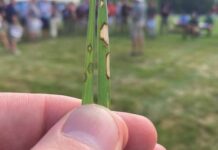Let’s get sensible about lawns in regions in the U.S. that are arid or periodically suffer severe droughts. Whenever water gets scare, lawns take a big hit from water agencies. Let’s get sensible about lawns in California.
Is it necessary for water agencies to always target lawns whenever water conservation becomes an issue? The answer, of course, is “no,” and certainly not to the extent that water suppliers—seemingly reacting in panic mode—often do. Industry and water suppliers can both benefit by getting on the same page about water use on turfgrass lawns. Industry and water agencies can drive water conservation by working more vigorously in tandem to educate property owners about smart irrigation and also smart lawns.
Smart lawns? Yes, smart lawns.
Not every lawn has to be as green and lush as the turfgrass at Augusta National Golf Course during Masters Week. Not every property has to be covered by turfgrass from property line to property line. If the only activity a large lawn receives is mowing, maybe a smaller lawn is a better option. Are homeowners aware of the species and cultivars of turfgrass that require minimal irrigation?
Nowhere is this lawns-versus-water issue playing out more starkly than in California where water agencies are turning the state into the poster child of anti-lawn sentiment. This past spring California Governor Jerry Brown, responding to the state’s four-year-long drought, directed the State Water Resources Control Board to impose restrictions to achieve a statewide 25 percent reduction in potable urban water use through Feb. 28, 2016. These restrictions will require water suppliers to California cities and towns to reduce usage as compared to the amount used in 2013. Brown also mandated that the Department of Water Resources lead a statewide initiative, in partnership with local agencies, to replace 50 million square feet of lawns and ornamental turf with drought tolerant landscapes.
Local agencies responded to Brown’s declaration with a host of water-conserving strategies, many of their new rules aimed at reducing water use on landscapes. Predictably, the irrigation of turfgrass lawns is being singled out as the biggest source of wasted water. Some of the state’s largest water suppliers are now doing all they can do to convince homeowners to replace their lawns by paying them to remove their turfgrass and replace it with drought-tolerant ornamentals, rocks or synthetic turf. For instance, The Metropolitan Water District, which provides water to 14 cities and 18 million people in Southern California, is adding $350 million to its lawn removal program.
These are not new water agency tactics. Some have been in place for a decade or more. But the attack on lawn grasses in favor of other landscape options turf has been accelerating since Gov. Brown’s call to severely cutback water use.
It’s easy, of course, to appreciate well-designed, attractively maintained landscapes consisting of drought-adapted ornamentals. But many of us are much less enthusiastic about properties (including parks) landscaped primarily with rocks or synthetic turf, which, in the end, is plastic grass. After all, who would want their children playing on gravel or on fake turf that, on a hot sunny day, can register a temperature of 130 degrees Fahrenheit, just above its surface.
The convenience and water savings that rocks and synthetic turf offer do not approach the many well-researched benefits offered by turfgrass lawns, which, in addition to their beauty, reduce runoff (capture water), cool the urban environment, capture and trap dust and provide a safe and soft surface for families to recreate and play on.
Obviously, there is a lot of work remaining to by both the green and water industries working closer to save lawns in California and in other water-stressed regions of the country. But in the end the decision of whether or not to save their lawns by conserving water will rely upon property owners’ buy-in and cooperation. It’s their decision to make. Let’s help them make the smart decision.











![[VIDEO] Dickies®: Discover Workwear That’s Anything But Uniform](https://turfmagazine.com/wp-content/uploads/2023/06/1647663814-4b1a2a7742790a9b1e97a3b963477850192e1d6a9dfba9b07214a77bae25d6e3-d-218x150.jpg)





























![[VIDEO] Dickies®: Discover Workwear That’s Anything But Uniform](https://turfmagazine.com/wp-content/uploads/2023/06/1647663814-4b1a2a7742790a9b1e97a3b963477850192e1d6a9dfba9b07214a77bae25d6e3-d-324x160.jpg)